| Columns Retired Columns & Blogs |
For years I always thought it was Kingwa or Kinwa?
PS: are we going to get some JA measurements on this????
Cheers George
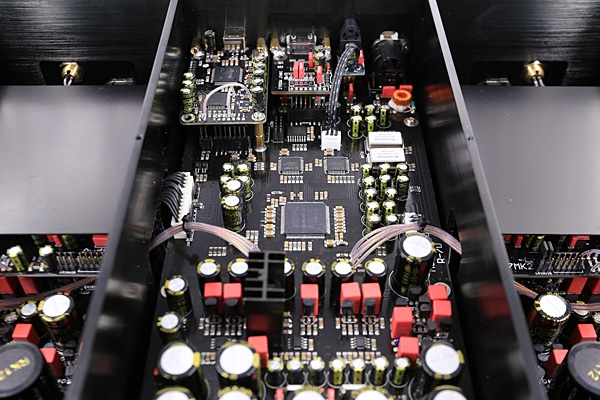
In an effort to prolong my detached listening, I've been starting my new-DAC listening sessions playing recordings with no voices, melodies, or attention-grabbing compositional development. I have an "ambient-electronic" playlist in Roon that I have played so often that I can now observe its diverse creations as a single, long, highly textured reference track. This playlist makes getting a preliminary feel for a new DAC easy. It was especially effective with Audio-GD's R7HE MK2 DAC ($4990, footnote 1), where it exposed the bold, heightened quality of this DAC's delivery.
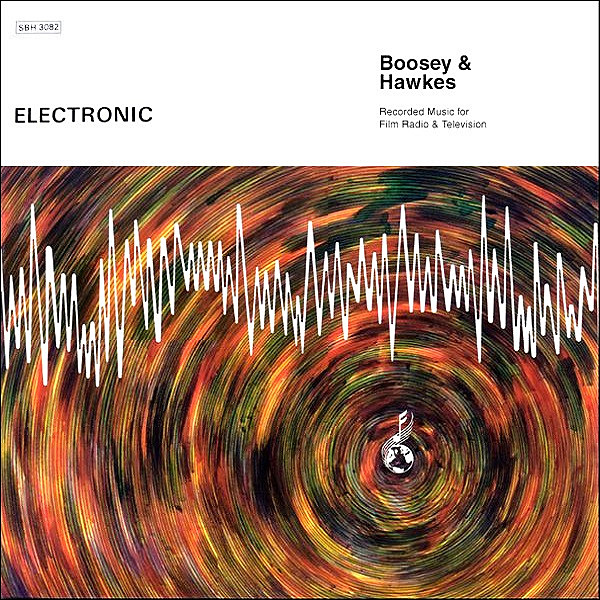
One example, from the end of that playlist: "Floatdown," the first track on Tod Dockstader's Recorded Music for Film, Radio & Television: Electronic, Vol. 2 (Original Mix) (16/44.1 FLAC Boosey & Hawkes/Qobuz). Dockstader's recorded sound sounded dramatically different through Audio-GD's R7HE MK2 than it did through the dCS Bartók or Mola Mola Tambaqui DACs. What was different was the quality of the R7HE's clarity: listening to recordings reminded me of looking at rocks and fish and sand just below the surface of a clear, freshwater pond. This shimmering, light-filled clarity endowed sounds with a transcendental beauty that I found extremely appealing. The Denafrips Terminator Plus and HoloAudio May DACs deliver a similar, natural-feeling clarity but present recordings less boldly—less dramatically—than the Audio-GD.
I am fascinated by DACs. I enjoy watching their sonics and technology evolve. But my religion forbids shilling for one DAC-design strategy over another. I tell everybody, "I regard all digital suspiciously" and consider most digital implementations to be either fashionable math or sonic trickery. There does not appear to be a single right or wrong way to convert bumpy data packets into powerful, live-sounding sound. Consequently, I judge digital's proclivities for musical pleasure and audio insight one DAC at a time, regardless of which conversion strategy is employed.
Describing the indescribable
To describe in words the sound of anything, I must resort to metaphor, simile, or onomatopoeia. To elucidate the sound character of the diverse DACs I review, I am obliged to describe—if I am able—the singular quality of each one's clarity. The nature of a DAC's clarity, along with its dynamic personality, is what distinguishes one DAC design from another. Describing a specific quality of clarity is a near-impossible task, one I've been wrestling with since I bought my first CD player in 1992. But for today, the best metaphor I can conjure is mirror and art glass in various thicknesses with more or less iron-oxide green reflecting at its edges.
My favorite NOS DACs, like the HoloAudio May and Denafrips's Terminator Plus, reproduce audio recordings with this vivid, looking-through-still-water clarity that I can now better describe as how my face looks in diffuse natural light reflected in a ¼"-thick glass mirror with a mercury or silver oxide backing.
Thick ruler-flat mirror glass, with top-quality silvering, reflects my image with the least grain and blur. Its high level of chromatic integrity makes the light illuminating my skin seem super-natural in its eerie evenness. In a thick glass mirror, dimensionality assumes a prominence more fantastic than natural, complimented by an acute emphasis on bas-relief textures. When I look at a room in a thick vintage mirror, it looks more vivid and 3D than it does when I observe it directly.
In the audio equivalent of these visual images, I use "vivid" to describe a sound I perceive as vibrant, luminous, and tubelike, with much reverb, glow, and brilliance.
In contrast, oversampling (OS) DACs make recordings seem like they are being reproduced through a contemporary mirror with thinner glass and a silver-paint backing. I can still see every pore, image focus is sharp, and tone balance is spot-on, but lighting, texture, and dimensionality are presented less dramatically than with NOS (footnote 2).
Every generalization has exceptions, and the Mola Mola Tambaqui DAC is an interesting one. It manufactures its own brand of rarified clarity, one that's less reflective and diffuse than any I'd previously encountered. The Tambaqui's transparency reminded me of expensive art-framing glass, called museum glass, which, like high-grade optical glass, is radically lower in iron and potassium contaminants, which results in a very low refractive index; its edges are clear, not green. Imagine glass so clear and diffusion-free that it disappears. In a museum, when it's properly lighted, a viewer might never realize there was glass in front of a painting if they weren't deliberately looking for it. Tambaqui-clear is like that.
I am introducing this glass-clarity metaphor because the Audio-GD R7HE MK2 digital-to-analog converter I am about to describe delivers a different, unusual form of transparency, which reminds me of how silvered thick-glass mirrors reflect their surroundings.
This Dream's examination of the $4990 R7HE MK2 digital-to-analog converter was motivated by (in addition to my partiality for NOS DACs) my suspicion that Audio-GD's signature current drive technology and regenerative power supply technology (included in the HE version reviewed here) might bring new forms of sound pleasure to the $5000 DAC scene. If they do, I want to tell you about them.
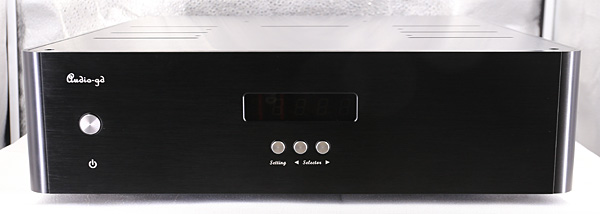
Audio-GD R7HE MK2 DAC
The Audio-GD website says, "All Audio-GD's products are made in China and designed and developed under the leadership of Mr. He Qinghua, the 'First Prize Winner' of the National Semiconductor (USA) Audio Design Contest." The website goes on to explain Audio-GD's signature engineering strategies: "With strong research and development capability in audio technology, Audio-GD offers a complete series of Hi-Fi equipment—DAC, preamplifier and power amplifier—with our signature 'Audio-GD Current Signal System' (ACSS) technology. Our ACSS technology transmits all audio signals via "Current" domain. ... In addition, we also master advanced audio technologies like power regeneration and fully balanced audio circuitry."
"ACSS is Audio-GD's system for transmitting audio signals in the current domain. This concept, first seen in 1966, we have used for many years, and since 2006, have evolved this technology to include all audio signals in our systems from the digital source to the power amplifier." I am intrigued by this.
I and many of my friends use transimpedance phono stages, so I am beginning to get a feel for the sound character of current-domain amplification. Naturally, I wondered if Audio-GD's ACSS might be playing a starring role in making the R7HE MK2 sound as liquid push-forward and beautiful as it does.
My daily-driver experience with Ron Sutherland's Little Loco transimpedance phono stage suggests that current drive enhances silence while preserving more small-signal information than traditional voltage amplification.
Audio GD says: "the R7HE employs eight sets of fully discrete R-2R DA modules to form a two-channel balanced push-pull decoder. There are also four sets of fully discrete and independent DSD hardware decoders. Two top-notch Accusilicon TCXOs with frequencies of 90 and 98MHz provide synchronization for the whole unit, and, they are applied to the playback of all data rates without PLL up-conversion. The R7's 32bit/384k asynchronous Amanero USB interface is synchronized with a FPGA." (The Amanero interface isn't especially common; the majority of DACs use XMOS or their own "proprietary" method; footnote 3.)
"The digital circuits of the whole DAC are comprised of 1 FPGA and 7 CPLDs (both programmable devices), which allow separating the different functional circuits and preventing interference. The FPGA operates in the parallel data processing mode even at the fastest data rate, and supports firmware upgrades to improve sound quality when new and better design ideas are eventually found and implemented."
The R7's front panel is simple and moderately elegant, consisting of a small LCD display that shows the input selected, digital mode, and sampling rate of the current track and four buttons: one for power, the other three to operate the menu to select inputs, choose digital modes (OS/NOS), enable PLL, program HDMI, and dim the display. (Warning: For me, the downloadable owner's manual description of how to navigate the menu, though in English, was not intuitive.)
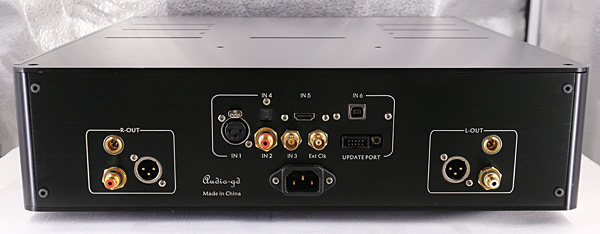
The R7HE MK2's back panel sports three output options: single-ended RCA (at 2.5V), fully balanced XLR (at 5V), and Krell CAST (ACSS, footnote 4) via MiniXLR (2+2mA), which I did not try. There is no Ethernet input, but there are six digital inputs: USB, I2S (over RCA and BNC), TosLink, AES3, and HDMI. There is also a BNC connector for an external clock and a 10-pin firmware-upgrade port.
The R7's USB and HDMI modules are galvanically isolated and fed by two groups of independent, isolated power supplies "to avoid the mutual electrical contamination between USB and HDMI."
In addition to its current drive and NOS technologies, Audio-GD's premier DAC undoubtedly benefits from its robust linear power supplies, which take up half the cabinet, and, in the HE version, employ four R-core transformers, the largest of which is for the R7HE MK2's AC power regenerator. That's right: To ensure the highest-quality power possible, the HE version of the R7 includes its own AC power regenerator. Power enters the DAC—of course—as 60Hz AC and is converted to DC "through a regenerative power input transformer," the company says; DC is then fed to the regenerative waveform generators "through a class-A parallel stabilized power supply." The generators produce an "ultra-low distortion 50Hz sinewave," which is amplified in a gain stage and directed to three power transformers, which output "pure, voltage, ... stable in terms of amplitude and frequency." These three regenerated AC outputs supply the power supplies for the digital board and the left and right analog output stages.
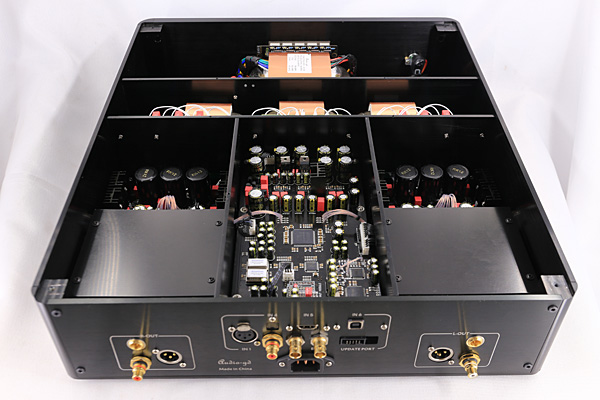
My limited experience with high-tech power cords and conditioners leads me to speculate that Audio-GD's power-regeneration technology and "class-A power supplies" might be responsible for some of that extra "force" I hear behind vocals and instruments.
I believe that the fundamental sound character of all audio amplification can be traced to the power supply. You want more forceful, detailed, and realistic sound? Put more power (and less impedance) in the power supply.
Footnote 2: What artist Herb has written here makes me think, also, of differences between modern digital and vintage film photography.—Jim Austin.
Footnote 3: Stereophile has reviewed digital products from ATC, Metronome, Verity, and Jadis that use the Amanero chip.—Tech. Ed.
Footnote 4: Another current-mode technology. See Wes Phillips's conversation about CAST with Krell's Dan D'Agostino here. I don't know, however, which other, current products support CAST.

For years I always thought it was Kingwa or Kinwa?
PS: are we going to get some JA measurements on this????
Cheers George

I imagine Qinghua, Kingwa and Kinwa are all transliterations of how the name sounds. Alternate character sets make life complicated.
IIRC, column reviews don’t get measurements.

As always, Herb writes a review with a great insight, useful comparison, and fun to read.

Saw OMA hosted a listening party and interview for this album via their Instagram account: Pigments by Dawn Richard and Spencer Zahn, spread across Movement 1 and Movement 2 on Tidal. Close your eyes and bathe in sonorous textures.

This has been a wonderful review, however I can't help but wonder how this DAC compares with the Rockna Wavedream.... That units currently on my list though now the R7HE Mk2 also has my attention....

What a lucky guy you are. Everything you review is just wonderful. No offense intended but you sound more like a manufacturers rep than a critical reviewer. I think J. Gordon Holt is cursing you from his grave.

Your ears were swayed by all those parts they stuffed in there, and by marketing hype. Look at https://www.audiosciencereview.com/forum/index.php?threads/audio-gd-master-7-singularity-review-dac.26460/ and https://www.audiosciencereview.com/forum/index.php?threads/audio-gd-master-7-singularity-dac-review-video.26573/ and https://www.audiosciencereview.com/forum/index.php?threads/review-and-measurements-of-audio-gd-r8.10149/ and https://www.audiosciencereview.com/forum/index.php?threads/review-and-measurements-of-audio-gd-r2r11-dac-amp.5779/

Without the measurements to ensure the objective review, IMHO, the review is just a "grumble". Useless. Period.

Standing on flowers pointing at tangentially related billboards.

After failing to make their DAC work with DSD, Mr Kingwa asked me to return it for a refund. I paid for the shipping and had it insured . But the Chinise customs wanted to charge import duties. Instead of taking care of the matter, mMe Kingwa blamed me for not having declared a false low value to clear customs. So in the end, Chinese customs focibly destroyed the unit. If you qwant to deal with Audio GD, this is the kind of service you will get. never agian for me.

Dear Mr Reichert, thank you very much for this inspiring review. It caused me buying this monster of a machine, May 2022. I continue to be amazed, every listening time. How can a digital device sound so forceful, direct, full of enthusiasm? I can fully confirm your review. My compliments to the developer(s).
I’d like to add a few observations.
1) I experimented adding an external clock (LHY OCK2). Result: NO! Even after some weeks of burn-in the external clock weakens all the strengths of this dac. While some people at head-fi recommended this pairing, I cannot. 2) Like probably with any other dac you should not use the USB connection directly from a computer. I put a ddc (singxer su-6) in between, using the i2s (hdmi) connection from ddc to dac. Great benefit. But only after replacing the provided power supply of the ddc with a linear power supply. Definitely worth the extra mile. A good streamer should provide the same benefit. 3) hqplayer: yes, I agree with Mr Reichert, nos (non-oversampling) sounds best with this dac. Still, this is an interesting upsampling player which I would like to recommend if you use a computer for playback and like to hear the differences in sound of the different algorithms.
Thanks to the whole Stereophile staff for your great work!